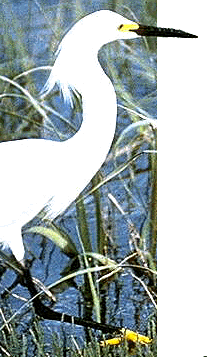 Snowy Egret
Snowy Egret
photo by B.Truitt
photo by B.Truitt
Nearly 50,00 people each year volunteer their time to record sightings of birds at Christmas time, providing the raw data for the best source of data on distribution and population for the many species of birds. Besides pear-bound partridges, birdwatchers are finding significant increases among eastern bluebirds, American crows, and American goldfinches and declines of bobwhites, loggerhead shrikes, field sparrows, and mockingbirds.
While the Audubon Society publishes the data in the journal Audubon Field Notes, it also provides its many years of Christmas Bird Count results to the United States Geological Survey, where the agency stores and analyses trends and patterns over time.
The USGS now has a Christmas Bird Count home page on the Internet, showing full color maps of bird distribution in the U.S. and Canada for the past 30 years. Also available is information on how you can join the program and become a trained observer in next year's bird count and see your efforts added to the web.
Available on the network are maps showing summaries for individual species and groups, charts comparing the decline or increase of a particular bird, and more.
The number of circles and participants has changed dramatically since the early years. While 1,508 circles were surveyed in 1986-1987, other years have had fewer volunteers, and thus fewer circles counted. The analysis available on the Internet tries to adjust for these differences.
Also of interest is the North American Breeding Bird Survey (BBS) from the Interior Department. Far more interesting than its bureaucratic name might indicate, the web site includes helpful tools for learning about birds, including identification tips, photographs, and recordings of birdsongs.
